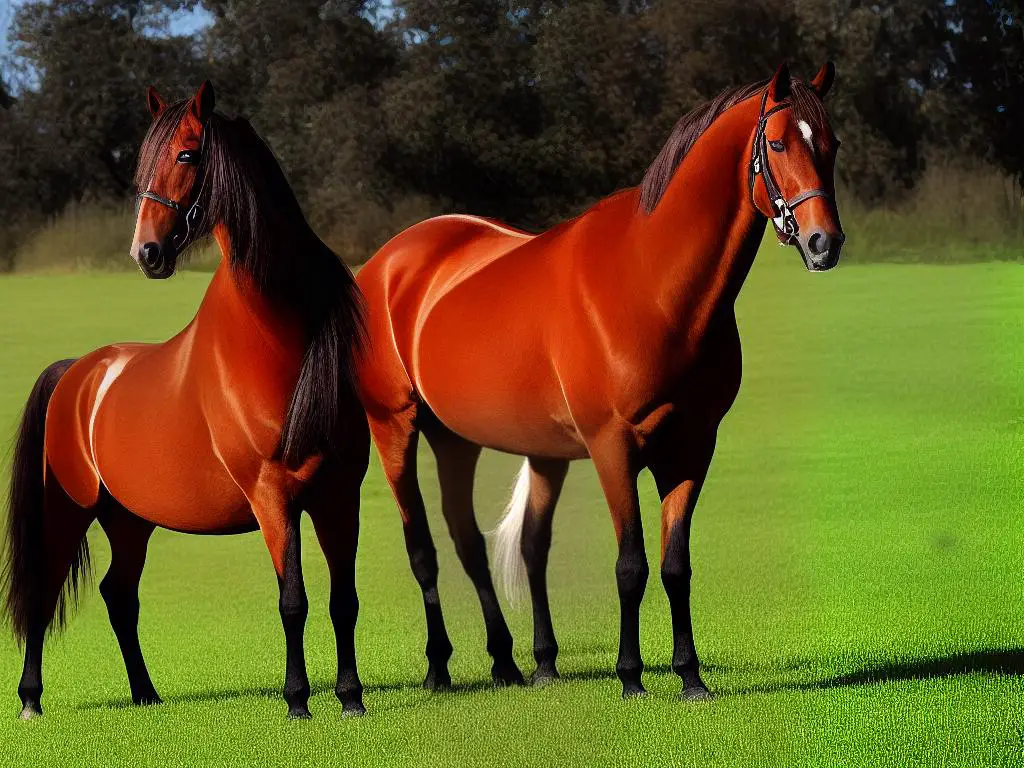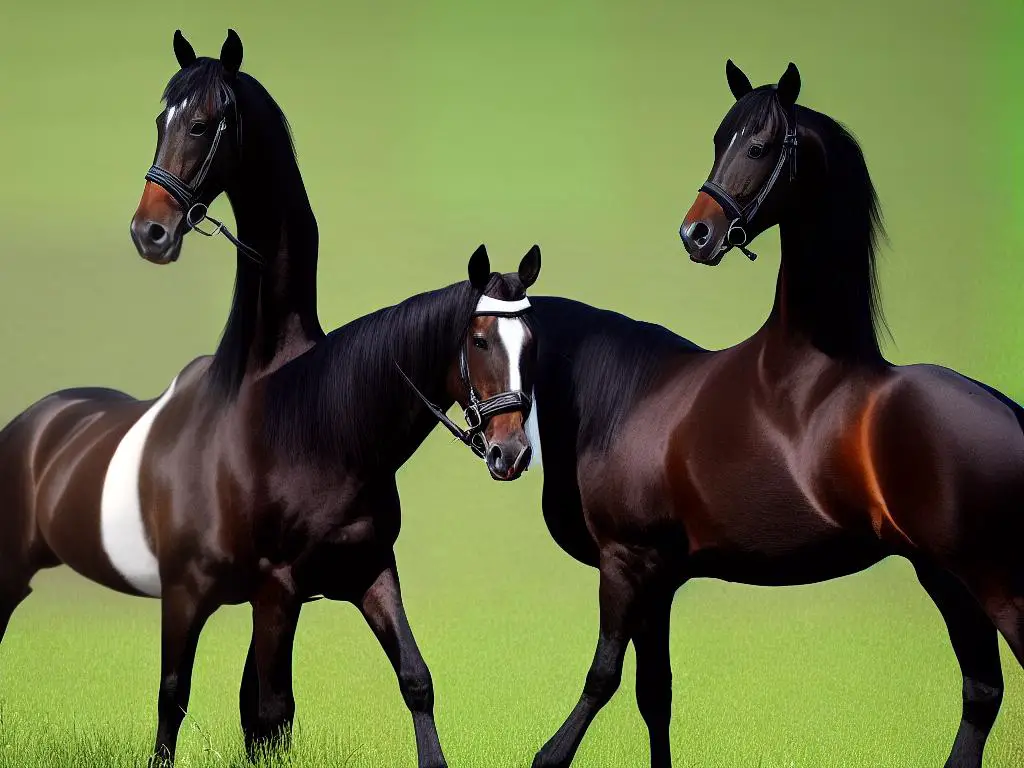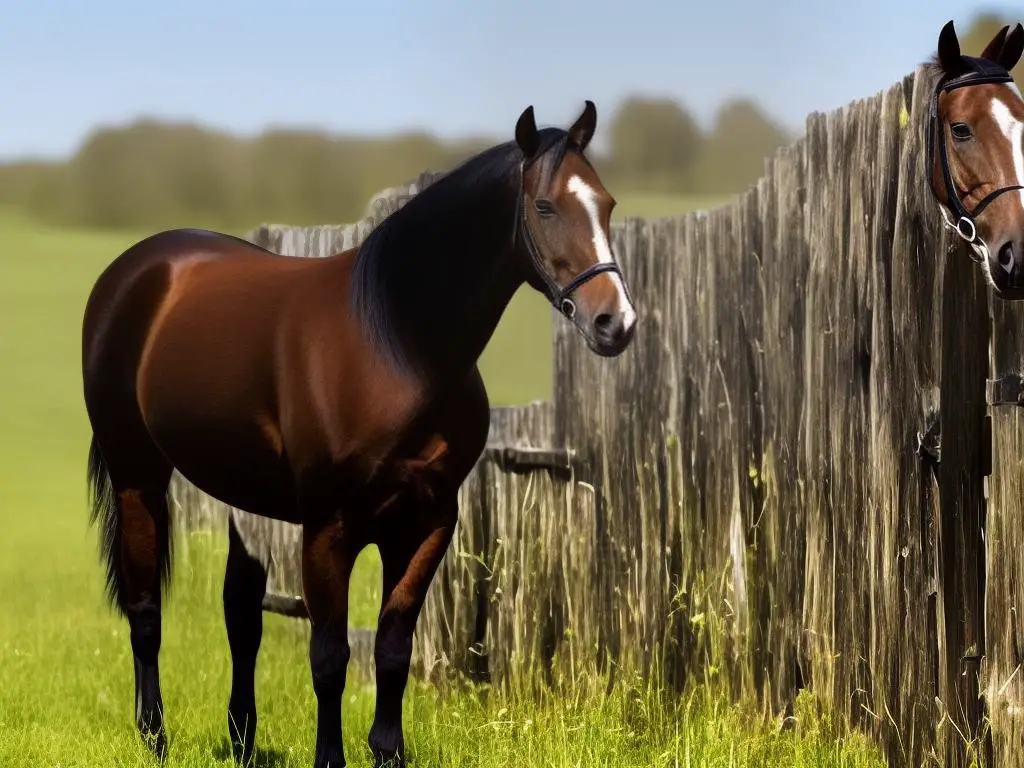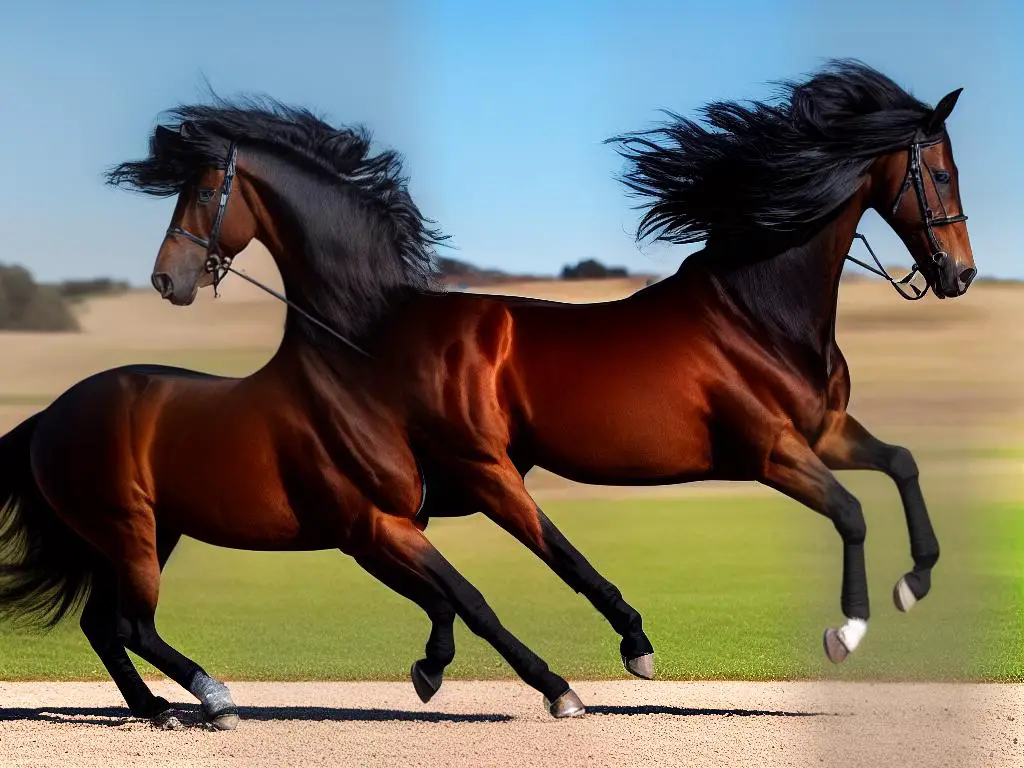Dating back centuries, the Hanoverian horse breed has a rich and storied history. Rooted in Germany, these horses have solidified their reputation worldwide as one of the most prestigious breeds, lauded for their athletic prowess, intelligence, and striking appearance. Over the years, the Hanoverian breed has evolved from humble workhorses to versatile sport horses – a testament to their impressive adaptability and resilience. This essay delves into the origins, physical attributes, talents, and health care of Hanoverian horses, offering a comprehensive overview for those interested in understanding or owning a horse of this magnificent breed.
Table of Contents (Horspedia)
The Origins and History of the Hanoverian Horse Breed
Hanoverian horses
are an exceptional breed that hailed from Germany. Starting back in the 16th century, this breed has evolved through careful and highly selective breeding practices. Known for its versatility, Hanoverian horses have made a name for themselves on a global scale in a variety of equine sports, especially in dressage, show jumping, and eventing. They’re famed for their athleticism, speed, and graciousness.
Historical Background and Origin
The Hanoverian horse breed traces back to the Kingdom of Hannover in northern Germany around the middle of the 16th century. King George II, influenced by the need for faster, yet versatile horses for use in agriculture and warfare, initiated the process of developing the Hanoverian breed. Initially, these horses were a blend of local German mares with imported Andalusian, Neapolitan, and oriental bloodlines – breeds admired for their endurance, speed, and agility.
Establishing the Hanoverian Breed in Germany
In the early 18th century, King George II established the State Stud of Celle, which fostered the breeding of Hanoverian horses. To improve the breed, English Thoroughbreds and Cleveland Bays were introduced, laying the groundwork for the Hanoverian breed known today. The goal of the breeding program was to produce a versatile horse that could be used for labor, transportation, and riding in warfare.
Global Spread of the Hanoverian Breed
As the Hanoverian breed evolved, its fame spread far beyond the borders of Germany. English Thoroughbreds and French horse breeds were brought in to refine the Hanoverian in the 19th century, creating a horse of outstanding quality. The breed quickly gained popularity in the equestrian world, making it one of the most popular and sought after breeds worldwide. The subsequent exportation of Hanoverian horses led them to be found in more than 60 countries worldwide by the start of the 21st century.
The Hanoverian as a Work Horse
The Hanoverian was originally a workhorse, used in fields for agricultural labor and as a carriage horse. They were resilient, powerful, and firm-bodied horses capable of heavy-duty work. In the 19th century, breeders started to focus on refining the breed, selecting for traits that would produce a livelier, more elegant horse without losing its strong build.
The Hanoverian as a Sport Horse
The Hanoverian’s transition into a high-performance sport horse started around the 20th century. Breeders began infusing more Thoroughbred blood into the breed for more agility, athleticism, and speed. The breed’s superior talents became clear on the international stage during the 1960s, marking their transition as a more sport-orientated breed and less of a working horse breed. Hanoverians are now recognised as some of the best competition horses worldwide, excelling particularly in dressage, show jumping, and eventing.
Unmatched Versatility of Hanoverian Horses
Marked by a blend of pure strength and regal elegance, the Hanoverian horse breed continues to prosper in diverse equestrian disciplines worldwide. The breed’s enduring presence, adaptability, and stellar performance consistently put it at the helm of the equestrian world. The continuous emphasis on meticulous and strategic breeding continues to ensure the breed’s dominance in the future. From its beginnings in Germany’s battlefields and farms to international competitive arenas, the Hanoverian horse has left an indelible imprint on the horse racing industry around the world.

Characteristics of Hanoverian Horse Breed
The Esteemed Hanoverian Breed
Well-regarded for its distinct characteristics, the Hanoverian breed is highly coveted and considered one of the most illustrious horse breeds globally. This breed, rooted in Germany, boasts specific attributes and qualities that evolved consistently over centuries and have now become the breed’s standard. The Hanoverian Society meticulously maintains these diverse traits, ranging from physical attributes, color, size, to temperament. This ensures the long-term preservation and consistency of the breed’s exceptional characteristics.
Physical Traits
One of the significant identifiers of Hanoverian horses is their physical traits. They are known for their powerful, well-muscled body, which offers strength and endurance. They have a medium-sized head with a straight profile, and their expressive eyes are said to mirror a lively intelligence. Another striking feature is their neck; It is long, strong, and well set on the shoulders, enabling high performance in athletic endeavors. The breed has a deep and broad chest, providing ample lung capacity, and their backs are strong and straight. Lastly, the legs of a Hanoverian horse are sturdy, long, and correctly set, possessing strong bone structure and well-defined joints.
Typical Size and Weight
As for the size, Hanoverian horses are large. The typical height of a Hanoverian horse is between 15.3 to 17.2 hands (63 to 70 inches), although exceptions may occur. Due to this significant size range, Hanoverian horses are commonly classified as warmbloods. Their weight ranges between 1,200 to 1,400 pounds, but again, individual variations may occur.
Common Colors and Markings
When it comes to color, Hanoverians come in all solid colors, with bay, chestnut, black, and grey being the most common. Although it’s less common, you may see a Hanoverian horse with a white marking, usually occurring on the horse’s face or lower legs. Such white markings, while not as prevalent, are considered to be quite striking and add to the horse’s distinguished appearance.
Temperament and Behavioral Traits
Regarding their temperament, Hanoverian horses are known for their exceptional intelligence, willingness to work, and amicable nature. They are generally calm and gentle, with a reliable and patient disposition. However, they are also highly energetic and require regular training and exercise to keep them content. Their exceptional learning ability, combined with these characteristics, makes them suitable for different equestrian activities, including dressage, show jumping, and eventing.
The Hanoverian Society plays a significant role in the preservation and development of this breed. All Hanoverian horses are carefully selected and bred to meet the high standards set by the society. Features such as physical conformation, movement, and temperament are all scrutinized along with the horse’s ability to perform athletically. The society also maintains a strict studbook and has stringent selection processes for stallions and mares to ensure the breed’s consistency.
Introduction
The Hanoverian horse breed is best known for embodying a natural blend of durability, elegance, and character. These horses’ versatility and persistent nature endear them to a wide range of riders. Physical attributes, such as their distinctive vibrant coats and well-muscled build, contribute to their unparalleled athleticism and charming temperament. The Hanoverian Society ensures the preservation of these qualities through strict regulation and vigilant monitoring of this breed.

Uses and Skills of Hanoverian Horses
Hanoverian Breed: Origin and Abilities
These warmblood horses come from Germany and are applauded globally for their range of skills and capabilities. The Hanoverian horses’ inherent agility and versatility have placed them prominently in the world of equestrian sports, exhibiting talent in dressage, showjumping, and eventing. With a powerful physique, well-structured conformation, and a high level of athleticism matched with an excellent disposition, the Hanoverian horse continuously holds its position as one of the most highly preferred breeds.
Versatility of Hanoverian Horses
Among the many valuable qualities of Hanoverian horses, their versatility stands out, lending them to be employed in a variety of disciplines. They are resilient animals, capable of adapting to the demands of different types of equestrian activities. This breed is inherently sturdy and robust, bearing a muscular build, well-proportioned frames, powerful hindquarters, and long, effortless strides. This extraordinary blend of physical traits provides them with the necessary strength and agility needed for many equestrian sports.
Hanoverians in Dressage
When it comes to dressage, Hanoverian horses are a sight to behold. Dressage demands both physical prowess and mental acuity, both of which are ingrained in the Hanoverian breed. Their natural aptitude for learning and focused, calm demeanor, combined with their graceful and fluid movement, make them excellent dressage competitors. Dressage requires the horse and rider to be in perfect harmony, executing intricate maneuvers with precision and elegance, which the Hanoverian breed executes effortlessly.
Showjumpng and Eventing with Hanoverian Horses
Hanoverians also dominate the realm of show jumping and eventing. They are notable for their keen senses, quick reflexes and strong bonds with their riders. Their tremendous power, usually derived from their strongly muscled hindquarters, aids in this athletic endeavor, enabling them to leap high fences with ease. Likewise, in eventing, a combination sport involving dressage, cross-country, and showjumping, Hanoverians perform exceptionally well. Their versatility, mental toughness, and physical endurance lend themselves perfectly to the rigors and variant demands of this discipline.
Hanoverian Horses: An Influential Breed
Hanoverian horses have continually upheld a significant stature in the equestrian world. They regularly rank highly among top breeds in the World Breeding Federation for Sport Horses (WBFSH) rankings, particularly in the disciplines of dressage and show jumping. These horses are a staple in global contests, frequently appearing in the Olympics and World Equestrian Games. Today, the attributes of Hanoverians such as their versatility, ease of training, and athleticism have further broadened their use beyond just competitive arenas. They are also used for leisure riding, light farm duties, and even in therapeutic horseback riding due to their gentle and thoughtful nature.
Throughout history, Hanoverian horses have been esteemed for their diverse abilities and affinity towards different disciplines. Their superior skills, paired with their mild and trainable disposition, have solidified them as a globally favored breed. From sports competitions to therapy sessions, their multifaceted nature and adaptable traits have made them a top pick among horse lovers across the world. The significant role they have played in shaping equestrian sports only accentuates their vital contribution in diversifying the global equine landscape.

Health and Care of Hanoverian Horses
Understanding the Hanoverian Horse Breed
Tracing its roots back to Germany, the Hanoverian horse breed is celebrated for its athletic prowess, smartness, and adaptability. These horses are most notable for their robustness, stamina, and disciplined demeanor, all of which require detailed attention and conscientious management to sustain. Caring for these horses entails a careful balance between nutrition, grooming, and training, bolstered with regular veterinary support and recurring physical evaluations.
Health Concerns
Hanoverian horses are blessed with a robust physique which aids in their excellent performance. Nevertheless, certain inherited health problems can sometimes develop. Wobbler Syndrome is observed in some Hanoverian horses. This debilitating condition affects the spinal cord, leading to an unsteady gait and general incoordination. Hanoverians may also be susceptible to Degenerative Suspensory Ligament Desmitis (DSLD), a condition that leads to lameness. Regular veterinary check-ups can catch and address such concerns before they exacerbate.
Lifespan and Veterinary Care
The typical lifespan of a Hanoverian largely depends on the care it receives. On average, these horses live to be around 25-30 years old. Regular veterinary care is a contributing factor to this longevity, and horse owners must provide their Hanoverian horses with regular vaccinations and deworming treatments. Annual dental check-ups are also recommended to maintain the horse’s oral health.
Diet and Hydration
The diet of a Hanoverian horse should be customized to its specific needs. These horses generally maintain high activity levels, and thus require a high-energy diet. This usually comprises of high-quality hay and grain, supplemented with vitamins and minerals as per the vet’s advice. Adequate hydration is equally crucial, and clean, fresh water should be accessible at all times.
Grooming and Hoof Care
Proper grooming practices for a Hanoverian horse not only maintain their immaculate appearance but also promote their physical health. Regular brushing stimulates blood flow and helps to uncover potential health issues hidden beneath the coat. Hoof care is also critical, as neglected hooves can lead to severe complications. Thus, hooves should be picked clean daily, and regular trimming by a professional farrier is advised.
Training and Potential
Training Hanoverian horses must be done with patience and consistency to tap into their keen intelligence and eagerness to learn. As these horses excel in various equestrian pursuits, they require diverse, flexible and targeted training regimens that optimize their natural capabilities.
Final Thoughts
In conclusion, the health and care of Hanoverian horses require a comprehensive approach. From regular veterinary care to tailored diets, from meticulous grooming to consistent and varied training, each aspect contributes to the overall well-being of the horse. Proper care and management practices will not only help avoid health issues and ensure a long, healthy life but also allow the horse to thrive in their respective fields, be it dressage, jumping, eventing or recreational riding. A healthy and well-cared-for Hanoverian horse is truly a sight to behold and a joy to ride.

Understanding the Hanoverian horse breed is to acknowledge the profound influence a single breed can have on equestrian sports and horse breeding worldwide. Renowned for their athleticism, versatility and agreeable temperament, Hanoverians hold a beloved status amongst horse lovers. However, they are more than mere athletes – their grace, strength, and intelligence have made them iconic in the world of horse breeding. With attentive care, a balanced diet, proper training, and regular veterinary attention, Hanoverian horses enhance equestrian pursuits by being a constant source of inspiration and fascination. Hanoverians serve as a benchmark of equine excellence, setting high standards for all sport horse breeds.
